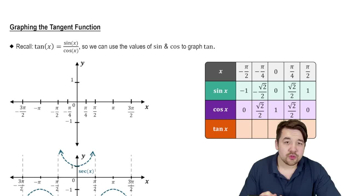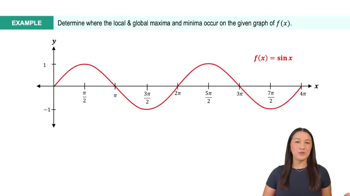Find the domain and range of the following graph (write your answer using interval notation).
Table of contents
- 0. Functions7h 54m
- Introduction to Functions16m
- Piecewise Functions10m
- Properties of Functions9m
- Common Functions1h 8m
- Transformations5m
- Combining Functions27m
- Exponent rules32m
- Exponential Functions28m
- Logarithmic Functions24m
- Properties of Logarithms36m
- Exponential & Logarithmic Equations35m
- Introduction to Trigonometric Functions38m
- Graphs of Trigonometric Functions44m
- Trigonometric Identities47m
- Inverse Trigonometric Functions48m
- 1. Limits and Continuity2h 2m
- 2. Intro to Derivatives1h 33m
- 3. Techniques of Differentiation3h 18m
- 4. Applications of Derivatives2h 38m
- 5. Graphical Applications of Derivatives6h 2m
- 6. Derivatives of Inverse, Exponential, & Logarithmic Functions2h 37m
- 7. Antiderivatives & Indefinite Integrals1h 26m
- 8. Definite Integrals4h 44m
- 9. Graphical Applications of Integrals2h 27m
- 10. Physics Applications of Integrals 3h 16m
- 11. Integrals of Inverse, Exponential, & Logarithmic Functions2h 31m
- 12. Techniques of Integration7h 41m
- 13. Intro to Differential Equations2h 55m
- 14. Sequences & Series5h 36m
- 15. Power Series2h 19m
- 16. Parametric Equations & Polar Coordinates7h 58m
0. Functions
Introduction to Functions
Problem 112b
Textbook Question
Daylight function for 40 °N Verify that the function D(t)=2.8sin(3652π(t−81))+12 has the following properties, where t is measured in days and D is the number of hours between sunrise and sunset.
Its maximum and minimum values are 14.8 and 9.2, respectively, which occur approximately at and , respectively (corresponding to the solstices).
 Verified step by step guidance
Verified step by step guidance1
Identify the function given: \( D(t) = 2.8 \sin\left(\frac{2\pi}{365}(t-81)\right) + 12 \). This is a sinusoidal function representing daylight hours over a year.
Determine the amplitude of the function. The amplitude is the coefficient of the sine function, which is 2.8. This indicates the maximum deviation from the average daylight hours.
Calculate the average daylight hours. The average value of the function is the constant term, which is 12. This represents the average number of daylight hours over the year.
Find the maximum and minimum values of the function. The maximum value occurs when the sine function equals 1, giving \( 2.8 \times 1 + 12 = 14.8 \). The minimum value occurs when the sine function equals -1, giving \( 2.8 \times (-1) + 12 = 9.2 \).
Verify the days when these extrema occur. The maximum occurs when \( \sin\left(\frac{2\pi}{365}(t-81)\right) = 1 \), which corresponds to \( t = 172 \). The minimum occurs when \( \sin\left(\frac{2\pi}{365}(t-81)\right) = -1 \), which corresponds to \( t = 355 \). These align with the solstices.
 Verified video answer for a similar problem:
Verified video answer for a similar problem:This video solution was recommended by our tutors as helpful for the problem above
Video duration:
9mPlay a video:
Was this helpful?
Key Concepts
Here are the essential concepts you must grasp in order to answer the question correctly.
Trigonometric Functions
Trigonometric functions, such as sine and cosine, are fundamental in calculus and describe periodic phenomena. In the context of the daylight function, the sine function models the variation in daylight hours throughout the year, reflecting the cyclical nature of seasons. Understanding how these functions behave, including their maximum and minimum values, is crucial for analyzing periodic data.
Recommended video:

Introduction to Trigonometric Functions
Periodicity
Periodicity refers to the repeating nature of a function over a specific interval. For the daylight function, the period is 365 days, corresponding to the annual cycle of daylight variation. Recognizing the periodicity helps in predicting values at different times of the year and understanding the function's behavior over time.
Recommended video:

Introduction to Tangent Graph
Maxima and Minima
Maxima and minima are points where a function reaches its highest or lowest values, respectively. In the context of the daylight function, identifying these points (14.8 hours and 9.2 hours) is essential for understanding the extremes of daylight throughout the year. Techniques such as calculus can be used to find these critical points, which are significant for interpreting the function's practical implications.
Recommended video:

Finding Extrema Graphically Example 3

 1:36m
1:36mWatch next
Master Introduction to Calculus Channel with a bite sized video explanation from Patrick
Start learningRelated Videos
Related Practice
Multiple Choice
